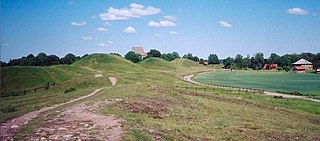
Gamla Uppsala is a parish and a village outside Uppsala in Sweden. It had 17,973 inhabitants in 2016.

African art describes the modern and historical paintings, sculptures, installations, and other visual culture from native or indigenous Africans and the African continent. The definition may also include the art of the African diasporas, such as: African-American, Caribbean or art in South American societies inspired by African traditions. Despite this diversity, there are unifying artistic themes present when considering the totality of the visual culture from the continent of Africa.
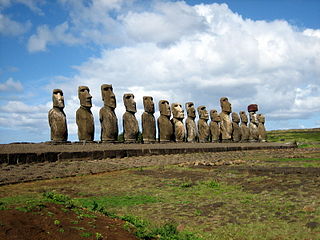
Moai or moʻai are monolithic human figures carved by the Rapa Nui people on Rapa Nui in eastern Polynesia between the years 1250 and 1500. Nearly half are still at Rano Raraku, the main moai quarry, but hundreds were transported from there and set on stone platforms called ahu around the island's perimeter. Almost all moai have overly large heads, which comprise three-eighths the size of the whole statue and they have no legs. The moai are chiefly the living faces of deified ancestors. The statues still gazed inland across their clan lands when Europeans first visited the island in 1722, but all of them had fallen by the latter part of the 19th century. The moai were toppled in the late 18th and early 19th centuries, possibly as a result of European contact or internecine tribal wars.

The Haniwa are terracotta clay figures that were made for ritual use and buried with the dead as funerary objects during the Kofun period of the history of Japan. Haniwa were created according to the wazumi technique, in which mounds of coiled clay were built up to shape the figure, layer by layer. Haniwa can also refer to offering cylinders, not the clay sculptures on top of them as well as the "wooden haniwa" found in Kofun tumuli.

The sculpture of ancient Greece is the main surviving type of fine ancient Greek art as, with the exception of painted ancient Greek pottery, almost no ancient Greek painting survives. Modern scholarship identifies three major stages in monumental sculpture in bronze and stone: the Archaic, Classical (480–323) and Hellenistic. At all periods there were great numbers of Greek terracotta figurines and small sculptures in metal and other materials.

The ancient Cycladic culture flourished in the islands of the Aegean Sea from c. 3300 to 1100 BCE. Along with the Minoan civilization and Mycenaean Greece, the Cycladic people are counted among the three major Aegean cultures. Cycladic art therefore comprises one of the three main branches of Aegean art.

Kurgan stelae or Balbals are anthropomorphic stone stelae, images cut from stone, installed atop, within or around kurgans, in kurgan cemeteries, or in a double line extending from a kurgan. The stelae are also described as "obelisks" or "statue menhirs".

Las Limas Monument 1, also known as the Las Limas figure or the Señor de las Limas, is a 55 centimetres (22 in) greenstone figure of a youth holding a limp were-jaguar baby. Found in the State of Veracruz, Mexico, in the Olmec heartland, the statue is famous for its incised representations of Olmec supernaturals. It is the largest known greenstone sculpture.
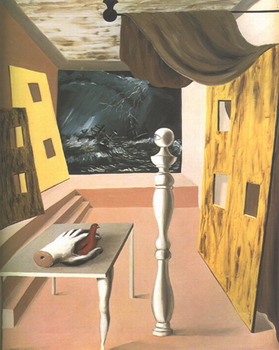
The Difficult Crossing(La traversée difficile) is the name given to two oil-on-canvas paintings by the Belgian surrealist René Magritte. The original version was completed in 1926 during Magritte's early prolific years of surrealism and is currently held in a private collection. A later version was completed in 1963 and is also held in a private collection.
The Shigir Sculpture, or Shigir Idol, is the oldest known wooden sculpture. It was carved during the Mesolithic period, shortly after the end of the last Ice Age, and is twice as old as Egypt's Great Pyramid. The wood it was carved from is approximately 12,000 years old.
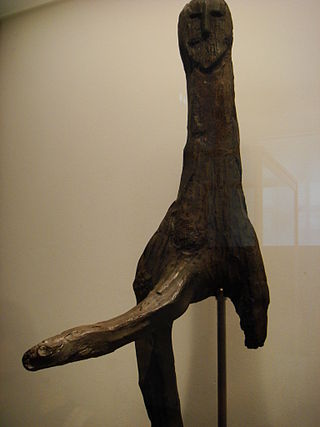
The Broddenbjerg idol is a wooden ithyphallic figure found in a bog at Broddenbjerg, near Viborg, Denmark and now in the National Museum of Denmark in Copenhagen. It is dated to approximately 535–520 BCE.
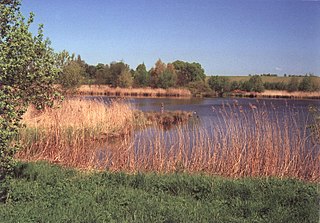
The Opfermoor Vogtei is an open-air museum at the location of a prehistoric and protohistoric sacrificial bog in the municipality of Vogtei, Thuringia, in Germany. It lies within the former municipality of Oberdorla, approximately 200 metres (220 yd) from Niederdorla, and the site is also known by those names.

Anthropomorphic wooden cult figurines, sometimes called pole gods, have been found at many archaeological sites in Central and Northern Europe. They are generally interpreted as cult images, in some cases presumably depicting deities, sometimes with either a votive or an apotropaic (protective) function. Many have been preserved in peat bogs. The majority are more or less crudely worked poles or forked sticks; some take the form of carved planks. They have been dated to periods from the Mesolithic to the Early Middle Ages, including the Roman Era and the Migration Age. The majority have been found in areas of Germanic settlement, but some are from areas of Celtic settlement and from the later part of the date range, Slavic settlement. A typology has been developed based on the large number found at Oberdorla, Thuringia, at a sacrificial bog which is now the Opfermoor Vogtei open-air museum.
The Sounion Kouros is an early archaic Greek statue of a naked young man or kouros carved in marble from the island of Naxos around 600 BCE. It is one of the earliest examples that scholars have of the kouros-type which functioned as votive offerings to gods or demi-gods, and were dedicated to heroes. Found near the Temple of Poseidon at Cape Sounion, this kouros was found badly damaged and heavily weathered. It was restored to its original height of 3.05 meters (10.0 ft) returning it to its larger than life size. It is now held by the National Archaeological Museum of Athens.
The Ralaghan idol, also known as the "Ralaghan figure", is a late Bronze Age anthropomorphic, carved wooden figure found in a bog in the townland of Ralaghan, County Cavan, Ireland. It is held by the National Museum of Ireland.

The statue of A'a from Rurutu is a wooden sculpture of the god A'a that was made on the Pacific island of Rurutu in the Austral archipelago. In the early nineteenth century, the sculpture was given by the islanders to the London Missionary Society to mark their conversion to Christianity. Following this, it was brought back to England to be displayed, first in the museum of the LMS and then in the British Museum. The figure of A'a is famous as one of the finest surviving pieces of Polynesian sculpture, and in the twenty-first century the sculpture is, according to Julie Adams, curator of the Oceania collection at the British Museum "an international celebrity".
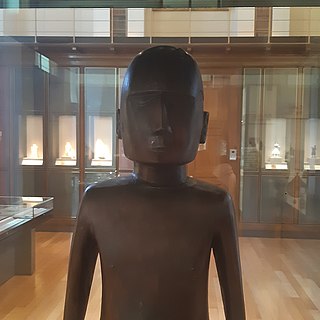
The Mangareva Statue or Deity Figure from Mangareva is a wooden sculpture of a male god that was made on the Pacific island of Mangareva in French Polynesia. The cult image was given to English missionaries in the early nineteenth century as the local population converted to Christianity. It was eventually bought by the British Museum in 1911.

The ʿAin Ghazal Statues are a number of large-scale lime plaster and reed statues discovered at the archeological site of ʿAin Ghazal in Jordan, dating back to approximately 9000 years ago, from the Pre-Pottery Neolithic C period. A total of 15 statues and 15 busts were discovered in 1983 and 1985 in two underground caches, created about 200 years apart.

The Corleck Head is a carved stone idol dated to the 1st or 2nd century AD. It was found c. 1855 in either Corleck Hill or the nearby townland of Drumeague, County Cavan, Ireland. The head is carved from a single block of local limestone and shows a three-faced (tricephalic) stone idol whose faces have enigmatic and haunted expressions, each having closely set eyes, a broad and rounded nose, and a simply drawn mouths.
















